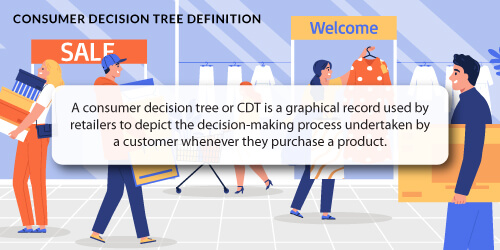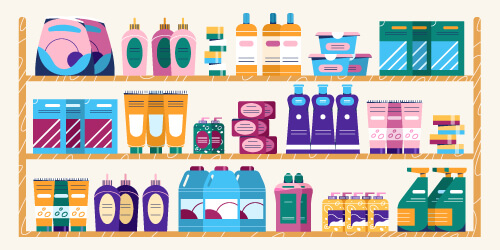There are many valid reasons for building consumer decision trees for your categories. For one, they allow you to organise your products logically*. They also allow for a more enjoyable shopping experience for your customers. Of course, before you build any consumer decision tree, you need a solid foundation.

The foundation or fundamentals, in this case, are vital. However, it's worth pointing out that while we've listed each fundamental, there is no specific order to their importance. In reality, you can't expect to have an efficient consumer decision tree if any one of the below elements is missing.

1. You need clean and classified data
As we noted in a previous article, a consumer decision tree depicts the decision-making process your customer undertakes when they purchase a product. In that article, we also mention the importance of data analysis.
That should make sense if you consider that one of the pillars of your consumer decision tree (CDT) is your retail data.
Of course, it’s one thing for you to have retail data. The fact that you sell or supply products means you have data available. However, it all counts for nothing if you can’t make sense of it. And that’s where clean and classified data comes in.
Let us explain.
Clean and classified data allows you to accurately allocate all of your products to a specific level of your category or product hierarchy. It also ensures that your data is free of inaccuracies such as duplicate SKUs or misspelt words.
The converse is also true - by classifying your data incorrectly or failing to clean it, you'll have an inaccurate consumer decision tree.
For example, if your data has products from two different categories and you don’t clean it, you might find yourself attempting to classify them within the same CDT. However, this isn't how your customers would usually purchase them and what you end up with is a shelf laid out with products that don’t make any sense to the shopper.
There is also the point that clean data accurately depicts the sales you generate and the amount of SKUs used in trade. If your data isn't clean or classified, you can't use it to justify why a product deserves more space or why you should merchandise it in a particular position on the shelf (like at eye level).
So how can you ensure clean and classified data?
- Fill out the blanks with your data to have all the necessary information.
All of your data must be in the same format. For example, all CAPS to ensure you don’t create duplicates when populating your data fields.
- Ensure all product descriptions are accurate.
By having all the necessary information, you can know what the product is and ensure that depicts it accurately
- Ensure that all the data used for sales, for example, use the same period or store/region.
If your data differs, it renders any project invalid, and you can't use it if you want to compare year-on-year growth.

2. You need access to a tried and tested methodology
While data is a must when building a consumer decision tree, it's critical that you also have a methodology to follow. And there are a few reasons why.
Tried and tested methodologies provide you with proven strategies that you can implement to target a specific market to influence them. Think about this: you can encourage customers to purchase more or try new products in a category.
Another reason is that having a methodology to follow can ensure that when you set up your CDT, it's one based on the needs and wants of your target market. That means a more enjoyable shopping experience for your customers, which can encourage them to return.

That feeds into another reason - a methodology is critical when building any consumer decision tree because it allows you to assess whether or not to continue presenting a category using a specific strategy.
For example, with your methodology (and using data such as current sales), you could look at a category and determine its strengths, weaknesses, opportunities and threats. From there, you could assess how consumers shop in it and learn what methodology to implement.
When it comes to a process or methodology to use when building a consumer decision tree, it depends on a few factors.
- Ensure you know and understand the category; and
- Use any information provided by your retail client (if you're a supplier or third party).
As for where to begin, a good suggestion would be to start at the top of your category hierarchy. So, go from category to sub-category to brand to sub-brand until you've laid out your entire CDT. How in-depth you go is entirely up to you.
When determining your consumer decision tree, you must establish whether the average consumer first shops by brand or sub-category.
Let's look at the Deodorant category to illustrate what we mean. A consumer likely identifies the deodorants and roll-ons separately. Therefore, splitting the product grouping into two sub-categories (deodorants and roll-ons) at a high level will simplify the shopping experience.

3. You must have a good understanding of shopper behaviour
Since the consumer decision tree forecasts how shoppers will make a purchase decision in a specific category, understanding how they behave should be a given.
There is also the point that the more you understand how a customer shops, the better you will be at merchandising your products in that category. After all, understanding shopping behaviour drives the objective of any CDT.
For example, with the right merchandising strategy based on shopper behaviour (established by looking at your retail data), you can increase sales and turnover of the category while simultaneously providing an enjoyable shopping experience.
[Free Ebook] The modern-day shopper is unlike shoppers of yesteryear and you need to know how to meet their demands and look after their needs. Learn how to take of them with our free ebook.
Applying this understanding of shopper behaviour leaves little to no room for error, whether you are a retailer or supplier, to merchandise the category based on the wrong CDT principles.
If, on the other hand, a customer has difficulty navigating your store or finding products, you're inviting them to leave your store to shop elsewhere.
So how should you go about learning and understanding shopping behaviour?
- Look at how you shop the category yourself
While not always scientifically accurate because you can't predict whether a customer will shop like you, it does provide you with a base. And you can do this across any category.
Let's use the example of wanting to bake muffins
You might want to shop by size first (500g instead of 1kg). Then shop according to brand since you aren’t brand-loyal. Finally, you'd shop by price. Bear in mind that this thought process differs from customer to customer, and it is vital to keep your target market in mind when creating your CDT.
Using this information and comparing it with any information received from a retailer or supplier, you can learn more about how shoppers behave when shopping in that category.
- Consider doing market research
Here, you can invite people that fit the persona of your ideal target market to answer questions about the category at hand. You can motivate this by providing incentives for their participation.
- Learn how to analyse your data and do research
That includes completing a category analysis. When your data shows that the top contributing brand differs in the different sub-categories, for example, it is most likely true that the shopper does not tend to stay brand loyal when making a purchase.

4. You must have a good understanding of the category
Understanding the shopper and how they behave when shopping in a category is one of the many aspects of designing a consumer decision tree that makes sense. However, you first need to understand your product grouping.
After all, if you don't understand the category, you'll struggle to understand anyone who shops it. And if you make such a mistake, you can create unappealing product layouts that take up space that you could use for products that will sell.

Let's say, for example, you know that your customer only shops for towels when in your store. You need to differentiate your range and price points to entice customers to enter your store. Once there, the consumer decision tree determines your layout to ensure a convenient and pleasant shopping experience for your customers.
Of course, it's not just about pleasing the customer. By understanding the category before building a CDT, you can ensure that you benefit from any strategy you want to implement in-store.
- Research your category
Doing so allows you to learn more and be more effective when assisting your retail or supplier client with any merchandising exercise.
- Perform a category assessment
Such an assessment can help you understand your category because you're looking at the market, consumer and category as a whole. From there, you can identify opportunities and put specific strategies and methodologies into place.
That includes researching the various products and brands within the category and consulting any collected data.
- Visit a store and shop the category as if you were a customer
When shopping in the chosen category, take notes on what you liked or disliked about your experience. Then take those notes and compare them against any data collected to see if there is a correlation between sales data for specific products and how you've merchandised them on the shelf.

5. You must have a good working relationship with your retail client
If you have ever built an effective consumer decision tree, you’ll know that it’s not something you can do on your own. As we have already pointed out, it involves many different aspects.
One aspect that we haven't yet touched on is the relationship between the person building the consumer decision tree and the retail client. It needs to be healthy.
Here's why: building a CDT is an interactive discussion between a retail buyer and the space planner. That's if you want to build one that delivers.
This interactive discussion encourages an open communication channel that will benefit you as a retailer as much as the person tasked with building the CDT. If it's you tasked with creating a consumer decision tree for your retail client, you can better understand what they want and implement these changes.
As the retailer, you can implement more changes on the planogram based on any changes to shopper behaviour. It also helps you to develop trust. As soon as your retail clients trust you with key decisions on merchandising or displaying categories, you can learn more about the product groupings you're working on to deliver better results.
For example, as a space planner, be empathetic but don’t appear to be a pushover. Show them that you're knowledgeable about their categories and interested in them becoming successful as this can build camaraderie and trust. If your retail client believes that you're knowledgeable about the grouping, they will be more accepting of any suggested changes to a layout or CDT.
Building a CDT allows you to get to know each other better and understand how the category functions and how shoppers behave when buying products from it.
It’s similar if you’re looking to improve your relationship with a space planner or third-party tasked with building planograms for you. Communication is key.

Conclusion
Building an effective consumer decision tree comes down to many different aspects. Having these fundamentals in place can mean the difference between a CDT working for or against your business.
Are you interested in learning to build a consumer decision tree that allows you to meet your goals and objective? Why not book a complimentary custom exploratory consultation with us here to find out how we can help set your retail business up for long-term success? You're also welcome to browse our various software and service packages on our online store here.
*This article was updated on 17 November 2022.


